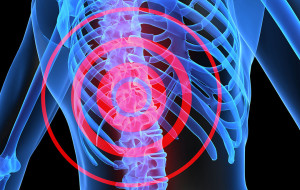Spinal injury conjures up images of urgent, life-threatening injuries that medical personnel manage
and treat. Normally this is in the setting of trauma, and treatment of these patients is critical. In
most cases, spinal damage will inflict immediate and permanent disability, seriously reducing a
patient’s quality of life.
However, many of us suffer from symptoms of less acute, chronic injury or spinal degeneration.
Due to the non-emergent and often non-traumatic nature of these injuries, they can often be underdiagnosed
and under-treated. Degenerative change can affect the discs, leading to bulges and
protrusions. It can also affect the joints of the spine (intervertebral, interspinous and facet joints),
leading to bone spurs and wear. Apart from causing direct pain, these can also place pressure on
adjacent nerves, leading to referred discomfort.
Medical imaging is now very effective at investigating the spine. Disc bulges and protrusions can
be often seen on CT scanning or MRI. Bone scans can also be useful in assessing the location
and severity of degenerative wear. Correlating images generated from these procedures enable
specialists to pioneer nonsurgical treatments that are often performed under the guidance of
medical imaging.
The development of interventional radiology (IR) has greatly improved speed of diagnosis, and
facilitated targeted, minimally invasive treatments. As you can imagine, interventional radiology is
quickly becoming influential and important to how a wide range of conditions are treated due to the
safety, convenience, and smarter treatment options it offers.
By diagnosing the “pain generator”, IR can be used to treat these regions specifically. Typically,
injections of local anaesthetic and an anti-inflammatory agent are performed directly to the site.
The facet joints, the epidural space or the nerve roots can be targeted. By delivering these
medications precisely to these deep and vital structures using minimally invasive techniques,
symptoms can be alleviated and patients may be potentially able be weaned from pain killers.
Spinal injections can be utilised as an adjunct to conservative management, such as exercise and
physiotherapy. Increased mobility and reduced pain may help in augmenting patients’ efforts in
increasing core strength and stability.
Spinal injections also play an important role in the care of any potential surgical candidates. In
some cases, they can be used as a successful alternative to surgery. In other cases, they can
either delay surgery, or ensure optimum pre-surgical condition. Even after surgery, injections can
still be utilised for symptomatic relief.
IR can even be used for treating pain from vertebral fractures. Vertebral fractures are a common
problem, particularly in the osteoporotic population. In this circumstance, softening of the bone
makes spinal fractures common, even in the setting of trivial trauma. Pain from these broken
vertebrae can be debilitating. However, the resulting immobility can lead to other issues such as
pneumonia, deep vein thrombosis and muscle atrophy in an already frail cohort. Reliance on pain
killers and their subsequent side effects can also lead to altered mood and depression.
Painful spinal fractures can be treated with vertebroplasty. Vertebroplasty is an example of imageguided
treatment. In these cases, the fractured bones are filled with cement. This consolidates and
solidifies the bony fragments. By stopping motion of the fracture fragments in this way, the fracture
pain is alleviated. This allows patients to be mobile, thus preventing their de-conditioning and
dependence on pain-killers.
Vertebroplasty and spinal injections are merely two of many less invasive and more convenient
spinal treatments that are facilitated by interventional radiology. Dr Albert Goh from Sydney
Medical Interventions is a specialist in this area and continues to develop more image-guided
techniques that may be used to treat injuries without radical and invasive procedures. To further
explore or enquire further about interventional radiology practices, please contact
info@sydneymedicalinterventions.com.au

